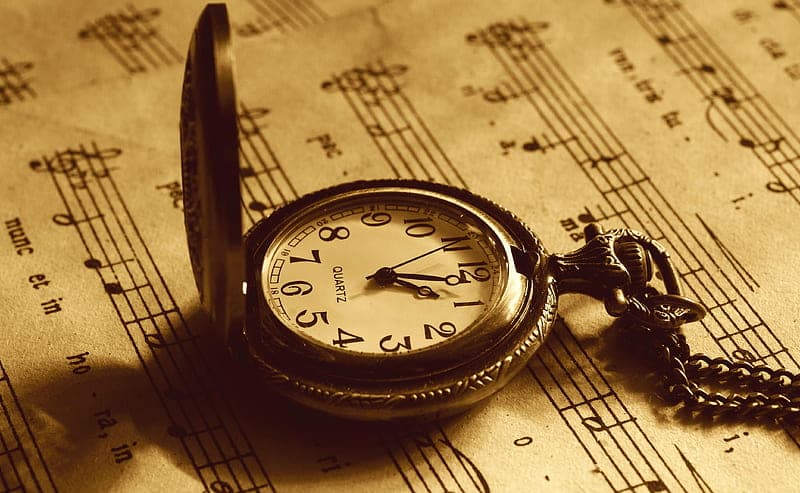Time, time-keeping, ticking watches, ticking clocks: all of these concepts have proven inspirational to composers of classical music.
Today we’re taking a look at centuries of classical music about time. There’s no time to waste, so keep reading!

© peakpx.com
John Dowland: Time Stands Still from The Third and Last Booke of Songs or Aires (1603)
John Dowland was an English composer who was born around 1563 and died in 1626. He is best known today for his melancholy, meticulously crafted songs.
“Time Stands Still” comes from his third collection of songs, published in 1603.
Joseph Haydn: Symphony No. 101 (1793-94)
Haydn’s 101st symphony is the ninth of his so-called London symphonies, which were written to be performed during the English tours he took later in his life.
The nickname “Clock” was given to this particular symphony because the steady pizzicato pulse in the second movement sounds like a clock ticking. You can hear that starting at 8:25 in the video above.
Listen to the elegant, mischievous melodic lines that Haydn crafts around that steady tick-tock pulse.
Ludwig van Beethoven: Pieces for a Mechanical Clock (1799)
In the late eighteenth century, mechanical musical clocks were all the rage.
These devices contained mechanisms that created sound when the clock struck a certain time, acting something like miniature pipe organs.
Many prominent composers wrote pieces for these clocks. That said, Mozart remarked in 1790 that he didn’t enjoy the task: “If it were on a large clock-work with a sound like an organ, I’d be glad to do it; but as it is a thing made up of tiny pipes only, which sound too shrill and childish for me.”
Beethoven wrote music for these clocks in 1799, but we don’t know if he enjoyed doing so, and the works weren’t known until after his death.
Maurice Ravel: L’heure espagnole (1911)
L’heure espagnole (translated, “The Spanish Hour” or “The Spanish Time”) is a one-act opera by Maurice Ravel.
It is set in Spain in the 1700s. The main characters are a clockmaker and his unfaithful wife. She decides to use large clocks as hiding places for her various lovers, to comic effect.
Zoltán Kodály: Viennese Musical Clock from Háry János (1926)
Háry János is a folk opera by Hungarian composer Zoltán Kodály. It illustrates the tall tales of a veteran peasant named Háry János who enjoys spinning yarns about his heroic exploits at the local tavern.
One of his most unbelievable, oddly charming stories is how he rescued Empress Marie Louise, Napoleon’s second wife, and how she fell in love with him.
According to Háry János, the empress brought him to a lavish Viennese palace, whose crowning design detail is an extravagant clock. This music plays on the hour as soldier figures circle around and then return back into the clock.
Olivier Messiaen: Quartet for the End of Time (1940)
French composer Olivier Messiaen was captured by German forces in June 1940 and sent to a POW camp. While being held there, he wrote a quartet for clarinet, violin, cello, and piano.
The work’s name was inspired by a passage from the Biblical book of Revelation, which includes the line, “And the angel which I saw stand upon the sea and upon the earth lifted up his hand to heaven, and sware by him that liveth for ever and ever…that there should be time no longer.”
The quartet has eight movements, and several of them address this concept of time ending, including “Vocalise, for the Angel who announces the end of time” and “Praise to the eternity of Jesus.”
Leroy Anderson: Syncopated Clock (1945)
American composer Leroy Anderson is famous for his orchestral pops pieces, such as Sleigh Ride, The Typewriter, and Blue Tango.
In 1945, Anderson came up with the idea of writing an orchestral work portraying a malfunctioning clock. He wrote the piece within a few hours.
Temple blocks are used to suggest the tick-tock of a clock. At various times throughout the piece, the rhythm hiccups, culminating in a recurring alarm clock brrrng in the bridge.
The piece ends with a boing as an unseen sleeper presumably whacks the clock in frustration.
John Cage: 4’33” (1952)
John Cage’s 4’33” is both famous and infamous. It was written for any instrument, and asks the musician to not play that instrument for four minutes and thirty-three seconds.
The reason? Cage wanted audiences and the performer to focus on the inevitable incidental noise of being in any particular performance space: for instance, the sounds of programs rustling, coughs, the hum of HVAC systems, and so on.
Cage believed that these kinds of sounds were music in and of themselves.
Steve Reich: Pendulum Music (1968)
In Pendulum Music, microphones are suspended on cables and swung back and forth over speakers.
The microphones swing near the speakers in a motion similar to the pendulum of a grandfather clock, creating feedback.
Reich described the end of Pendulum Music like so: “The piece is ended sometime shortly after all mikes have come to rest and are feeding back a continuous tone by performers pulling the power cords of the amplifiers.”
Wolfgang Rihm: Time Chant (1991-92)
Composer Wolfgang Rihm was born in Germany in 1952. In the early 1990s, he wrote an otherworldly violin concerto called Gesungene Zeit, or Time Chant. He dedicated it to violinist Anne-Sophie Mutter.
Gérard Grisey: Vortex temporum (1995)
Vortex temporum (or, translated, The Whirlpools of Time) is a three-movement work for six musicians by late French composer Gérard Grisey.
He was born in 1946 in France and studied with Olivier Messiaen, whose Quartet for the End of Time we mentioned above.
Grisey wrote of this work that it’s a “a story of an arpeggio in space and time.”
Different movements explore the relationship between sound and time. The first has a kind of calculated agitation to it, while the second has an eerie stillness and sense of being suspended in time.
Harrison Birtwistle: Harrison’s Clocks (1997-98)
In the mid-eighteenth century, clockmaker John Harrison invented a device called the marine chronometer, which determines longitude on seagoing vessels. It took three decades of experimentation before he perfected his invention.
This work by (the appropriately-named) composer Harrison Birtwistle consists of five pieces, each a portrait of a forerunner timepiece, followed by Harrison’s ultimate breakthrough.
This music presents an immense technical challenge for any pianist.
Michael Daugherty: Time Machine (2003)
Time Machine is written for three separate ensembles and three separate conductors who all perform in the same space.
Composer Michael Daughtery explained the concept of the work:
Time Machine is an adventure in rhythm, sound and space for three conductors and orchestra. Twenty minutes in length, my composition is divided into two movements entitled “Past” and “Future.” By dividing the orchestra into three spatially separated orchestras, I represent the three dimensions of space: forward-backward; left-right; up-down. Orchestra I is located stage right, Orchestra II is located stage left and Orchestra III is located center stage… When the three orchestras play simultaneously, they create a three-dimensional music that makes it possible to travel through the fourth dimension of time.
Hans Zimmer: Time from Inception (2010)
In 2010, director Christopher Nolan wrote and directed a mind-bending film called Inception. It follows a man (played by Leonardo di Caprio) who can infiltrate people’s subconscious and steal and implant information.
Nolan imagined time moving at a different speed on different layers of the subconscious.
Zimmer portrays a terrifying pulse in his orchestral score for the film.
Serj Tankian: Disarming Time: A Modern Piano Concerto (2020)
Musician Serj Tankian leads heavy metal band System of a Down. He has collaborated with musicians from other genres before. In 2009 he recorded an album with the Auckland Philharmonia Orchestra, called Elect the Dead Symphony.
When he was forced into quarantine during the Covid-19 epidemic, he decided to weave snippets of unfinished ideas he had on his phone into a larger piece, which ultimately became Disarming Time: A Modern Piano Concerto.
Disarming Time merges music and poetry, as well as an official music video.
Conclusion
Tick-tock: time is up! We hope you enjoyed this exploration of time in classical music. Now it’s time for you to share your favorites in the comments!
For more of the best in classical music, sign up for our E-Newsletter


Alkan wrote several piano works with time in the title, he also asks the pianist to imitate a striking clock in the 3rd movement of the Grande Donate, The 4 Ages (Op.33)